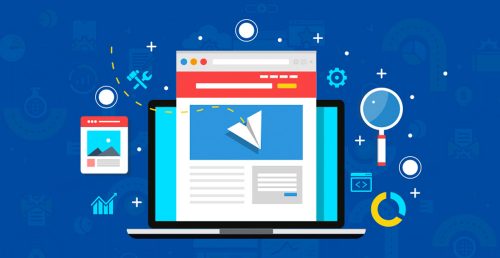Creating a high-converting landing page is essential for any business looking to maximize its online presence and drive conversions. A landing page serves as the first point of contact between potential customers and your brand, making it crucial to design it effectively to encourage action. In this blog, we’ll explore key elements and strategies to help you build a landing page that not only attracts visitors but also converts them into leads or customers.

Table of Contents
Toggle1. Define Your Goal
Before you start designing your landing page, it’s important to define its purpose. What action do you want your visitors to take? Common goals for landing pages include:
- Signing up for a newsletter
- Downloading a free resource (e.g., eBook, whitepaper)
- Making a purchase
- Registering for a webinar or event
Having a clear goal in mind will guide your design and content choices, ensuring that everything on the page is focused on driving that action.
2. Craft a Compelling Headline
The headline is the first thing visitors see when they arrive on your landing page, so it needs to grab their attention immediately. A strong headline should be:
- Clear: Clearly communicate the value proposition or offer.
- Concise: Keep it short and to the point.
- Engaging: Use action words or questions to pique interest.
Example:
Instead of “Sign Up for Our Newsletter,” try “Unlock Exclusive Tips and Resources – Join Our Newsletter Today!”
3. Use Subheadings to Support Your Headline
Once you have captured the visitor’s attention with your headline, use subheadings to provide additional context and reinforce the value of your offer. Subheadings should complement the main headline and help guide visitors further down the page.
Example:
“Get the Latest Industry Insights and Proven Strategies Delivered to Your Inbox Weekly.”
4. Focus on Benefits, Not Just Features
When presenting your offer, emphasize the benefits to the user rather than just listing features. Potential customers want to know how your product or service will improve their lives or solve their problems.
Example:
Instead of stating, “Our software includes analytics tools,” say, “Gain valuable insights into your marketing performance and make data-driven decisions that boost ROI.”
5. Design for Visual Appeal
A visually appealing landing page can significantly enhance user experience and increase conversions. Consider the following design elements:
- Color Scheme: Use a color scheme that aligns with your brand and evokes the desired emotions. Ensure sufficient contrast between text and background for readability.
- Images and Graphics: Incorporate high-quality images or graphics that support your message and create visual interest. Avoid stock photos that appear generic or overused.
- Whitespace: Use whitespace strategically to prevent clutter and improve readability. It helps draw attention to important elements like your call-to-action (CTA).
6. Create a Strong Call-to-Action (CTA)
Your CTA is the action you want visitors to take, so it should be prominent and persuasive. Here are some tips for creating an effective CTA:
- Use Action-Oriented Language: Phrases like “Get Started,” “Download Now,” or “Claim Your Free Trial” create a sense of urgency and encourage users to act.
- Make It Stand Out: Use contrasting colors and larger fonts for your CTA button to make it easily noticeable.
- Place It Strategically: Position your CTA above the fold and repeat it throughout the page, especially after sections that build interest.
7. Incorporate Social Proof
Social proof, such as testimonials, reviews, or case studies, helps build trust and credibility. By showcasing positive experiences from past customers, you can alleviate potential concerns and encourage visitors to convert.
Example:
Include a testimonial section with quotes from satisfied customers, along with their names and photos if possible, to make it more authentic.
8. Optimize for Mobile
With a growing number of users accessing websites on mobile devices, it’s essential to ensure that your landing page is mobile-friendly. Here are some mobile optimization tips:
- Responsive Design: Use responsive design techniques to ensure your landing page adjusts seamlessly to different screen sizes.
- Fast Loading Speed: Optimize images and minimize code to improve loading times, as slow pages can lead to high bounce rates.
- Simplified Forms: If your landing page includes forms, keep them short and easy to complete on mobile devices.
9. Use A/B Testing
To continuously improve your landing page’s performance, consider conducting A/B tests. This involves creating two versions of your landing page (A and B) with slight variations (e.g., different headlines, images, or CTA buttons) and measuring which one performs better.
Example:
Test different headlines to see which one generates more conversions. Analyze the results to inform your future landing page designs.
10. Analyze and Iterate
Once your landing page is live, regularly monitor its performance using analytics tools. Track key metrics such as conversion rates, bounce rates, and time spent on the page. Use this data to identify areas for improvement and make informed adjustments to optimize your landing page further.
Example:
If you notice a high bounce rate, consider revisiting your headline or design elements to ensure they align with visitor expectations.
Conclusion
Building a high-converting landing page requires careful planning, design, and optimization. By defining your goals, crafting compelling content, focusing on user experience, and utilizing data-driven strategies, you can create a landing page that not only attracts visitors but also drives conversions. Remember, continuous testing and iteration are key to maximizing your landing page’s effectiveness and achieving long-term success. Start implementing these strategies today and watch your conversion rates soar!


No responses yet